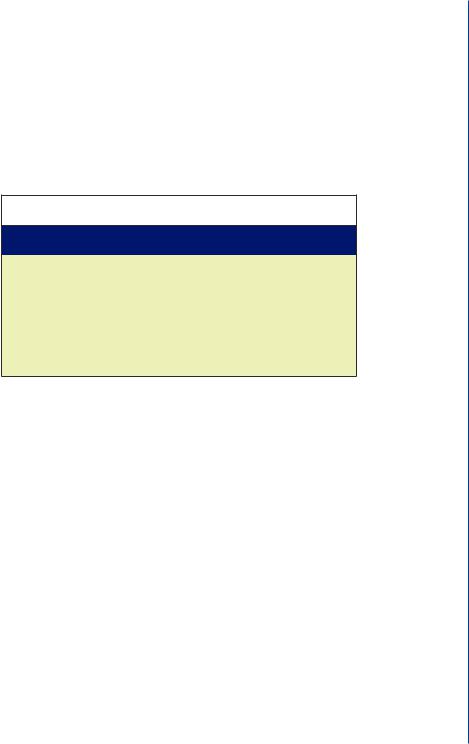
- •Introduction to Statistics for Biomedical Engineers
- •ABSTRACT
- •Keywords
- •Contents
- •3.1 WHY DO WE COLLECT DATA?
- •3.2 WHY DO WE NEED STATISTICS?
- •3.3 WHAT QUESTIONS DO WE HOPE TO ADDRESS WITH OUR STATISTICAL ANALYSIS?
- •3.4.1 Scatterplots
- •3.4.2 Time Series
- •3.4.3 Box-and-Whisker Plots
- •3.4.4 Histogram
- •3.5 GENERAL APPROACH TO STATISTICAL ANALYSIS
- •3.6 DESCRIPTIVE STATISTICS
- •3.7 MEASURES OF CENTRAL TENDENCY
- •3.8 MEASURES OF VARIABILITY
- •4.1 THE STANDARD NORMAL distribution
- •4.2 The normal distribution and sample mean
- •4.3 CONFIDENCE INTERVAL FOR THE SAMPLE MEAN
- •5.1 COMPARISON OF POPULATION MEANS
- •5.1.1 The t Test
- •5.1.1.1 Hypothesis Testing
- •5.1.1.2 Applying the t Test
- •5.1.1.3 Unpaired t Test
- •5.2 COMPARISON OF TWO VARIANCES
- •5.3 COMPARISON OF THREE OR MORE POPULATION MEANS
- •5.4 ONE-FACTOR EXPERIMENTS
- •5.5 TWO-FACTOR EXPERIMENTS
- •5.6 TUKEY’S MULTIPLE COMPARISON PROCEDURE
- •The Correlation Coefficient
- •7.1 POWER OF A TEST
- •7.2 POWER TESTS TO DETERMINE SAMPLE SIZE
- •Bibliography
- •Author Biography

Statistical Inference 69
There are two questions we wish to address with these data:
1.Using α = 0.01, does the mean number of failures differ significantly as a function of device type?
2.Using α = 0.01, does the mean number of failures differ significantly as a function of year after implant? In other words, is year after implant a major source of variability between populations?
Again, rather than estimate the calculations by hand, we may use statistical software, such as Minitab, to obtain the following results using ANOVA with block:
ANOVA for number of failures
Source |
df |
SS |
MS |
F |
|
|
|
|
|
Device |
3 |
173.188 |
57.729 |
35.67 |
|
|
|
|
|
Year |
3 |
20.688 |
6.896 |
4.26 |
|
|
|
|
|
Error |
9 |
14.563 |
1.618 |
|
|
|
|
|
|
Total |
15 |
208.438 |
|
|
The F statistic for device, F = 35.67, is greater than the critical F value, F(0.01, 3, 9) = 6.99, given in the F table. Thus, we can reject the null hypothesis and accept that alternative hypothesis that at least one of the devices differs from the remaining devices in the mean number of failure. The second part of the questions tests the hypothesis that the mean number of failures differs significantly as a function of year after implant (the blocking factor). The F statistic for year, F = 4.26, is less than the critical F value, F(0.01, 3, 9) = 6.99, given in the F table; thus, we accept our null hypothesis, which means failure rate does not differ between years after implant.
5.3.2 Two-Factor Experiments
In the original biomedical engineering challenge describing hip flexion reflexes, we discussed two factors that influence hip flexion: ankle speed and range of ankle extension.
In a two-factor experiment leading to a two-way ANOVA, there are two factors being varied, A and B, where A has a treatments and B has b treatments, and there are n samples at every combination of A and B.
The two-factor experiment is said to be completely crossed if there are samples collected for every combination of factors A and B. In addition, the experiment is said to be balanced if we have same number of samples for every combination of factors A and B.

70 introduction to statistics for biomedical engineers
Table 5.6 below illustrates a two-factor experiment that is completely balanced and crossed. Each of the two treatments within factor A is crossed with each of the three treatments within factor B. Also note that for each combination of A and B, we have three samples.
The question that we are trying to address with a two-factor ANOVA is whether there are differences in treatment means for each of the two factors. In addition, we wish to know if there are interaction effects such that there are significant differences in means as a function of the crossinteraction between factors. In other words, there are significant differences in sample means, and hence, the means of the underlying populations, when specific combinations of factors A and B occur together.
Once the data have been collected, as illustrated in Table 5.6 above, we may perform a twofactor ANOVA to test the following three null hypotheses:
H0: A1 = A2 = A3 = …. = Aa;
H0: B1 = B2 = B3 = …. = Bb;
H0: A1B1 = A1B2 = A1B3 = A2B1 = A2B2 = … = AaBb.
For each of the three null hypotheses, the associated alternative hypothesis is that there is a significant difference in at least two of the population means for a given factor or combination of factors.
The analysis and results of a two-factor ANOVA may be organized as in Table 5.7 [3]. The equations for the SS and MS for each of the factors and interaction factors are beyond
the scope of this text but may be found in [3]. In practice, the investigator will use a popular statistical software package such as Minitab, SPSS, or SAS to estimate these SS and MS values (because of computational burden) and simply refer to the F statistics to reject or accept the null hypotheses.
TABLE 5.6: Two-factor experiment
|
|
Factor B |
|
|
|
|
|
Factor A |
1 |
2 |
3 |
|
|
|
|
1 |
1.2, 1.4, 2.1 |
2.3, 2.2, 2.6 |
6.4, 5.8, 3.2 |
|
|
|
|
2 |
3.2, 4.1, 3.6 |
4.1, 4.3, 4.0 |
8.2, 7.8, 8.3 |

Statistical Inference 71
TABLE 5.7: Two-factor ANOVA table (each with multiple treatments)
Source |
df |
SS |
MS |
F |
|
|
|
|
|
A |
a − 1 |
|
|
MSA/MSerror |
B |
b − 1 |
|
|
MSB/MSerror |
AB |
(a − 1)(b − 1) |
|
|
MSAB/MSerror |
Error |
ab(n − 1) |
|
|
|
We note that there are three F statistics to test each of the three null hypotheses described earlier. In each case, we compare our estimated F statistic with the F values in our F table representing the F distribution. More specifically, we compare our estimates F values to the following table entries:
To test H0: µA1 = µA2 = µA3 = …. = µAa, compare FA with F (α; a − 1, ab(n − 1)); To test H0: µB1 = µB2 = µB3 = …. = µBb, compare FB with F (α; b − 1, ab(n − 1));
To test H0: µA1B1 = µA1B2 = µA1B3 = µA2B1 = µA2B2 = …= µAaBb,
compare FAB with F (α; (a − 1)(b − 1), ab(n − 1)).
In each of the three tests, if the estimated F statistic is greater than the table entries for the F distribution, one may reject the null hypothesis and accept the alternative hypothesis with (1 − α) × 100% confidence.
Example 5.6 An example of a two-factor experiment that will be evaluated using two-factor ANOVA occurs when biomedical engineers are looking at the effectiveness of rehabilitative therapy and pharmacological therapy on the recovery of movement in a limb after stroke. Details of the experimental design include the following:
1.Factor T: therapy used (there are three types of therapies, T1, T2 and T3);
2.Factor D: drug used (there are three types of Drugs, D1, D2 and D3);
3.36 patients are randomly assigned to each combination of T and D;
4.measure: number of days to meet recovery criteria.

72 introduction to statistics for biomedical engineers
Experimental design for two factors
|
T1 |
|
|
T2 |
|
|
T3 |
|
|
|
|
|
|
|
|
|
|
D1 |
D2 |
D3 |
D1 |
D2 |
D3 |
D1 |
D2 |
D3 |
|
|
|
|
|
|
|
|
|
20 |
25 |
13 |
22 |
8 |
16 |
9 |
15 |
7 |
|
|
|
|
|
|
|
|
|
15 |
16 |
12 |
16 |
10 |
19 |
12 |
10 |
10 |
|
|
|
|
|
|
|
|
|
18 |
10 |
22 |
17 |
9 |
11 |
8 |
9 |
9 |
|
|
|
|
|
|
|
|
|
24 |
20 |
10 |
12 |
11 |
21 |
8 |
10 |
9 |
The questions we are trying to address is whether there is a significant difference in mean days of recovery for the three types of rehabilitative therapy, the mean days of recovery for the three types of drug therapy, and differences in mean days of recovery for the nine combinations of rehabilitative therapy and drug therapy (interaction effects).
ANOVA analysis performed using statistical software, known as Minitab, produces the following table summarizing the ANOVA analysis. Note that there are three estimated F statistics. We can use the three F values to test our hypotheses:
H0: T1 = T2 = T3;
H0: D1 = D2 = D3;
H0: T1D1 = T1D2 = T1D3 = T2B1 = T2B2 = … = T3D3.
Two-way ANOVA for days of recovery versus T and D
Source |
df |
SS |
MS |
F |
α |
|
|
|
|
|
|
T |
2 |
337.4 |
168.7 |
11.44 |
0.000 |
|
|
|
|
|
|
D |
2 |
36.2 |
18.1 |
1.23 |
0.309 |
|
|
|
|
|
|
Interaction |
4 |
167.8 |
41.9 |
2.84 |
0.043 |
|
|
|
|
|
|
Error |
27 |
398.3 |
14.8 |
|
|
